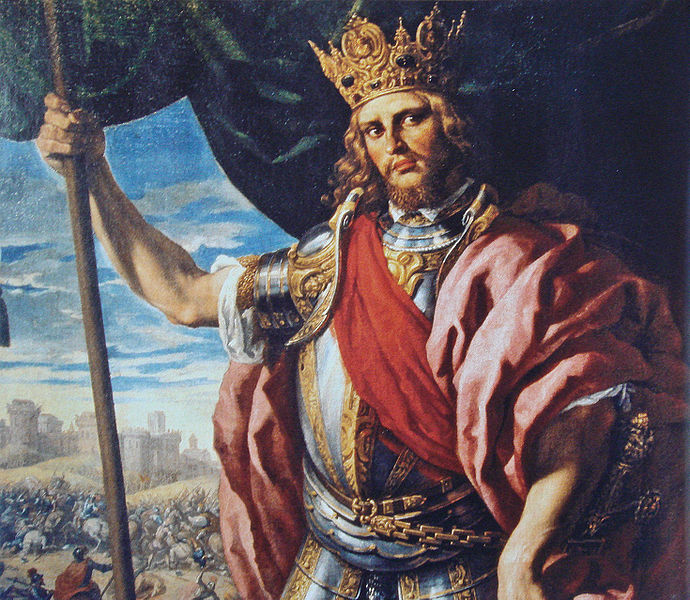<Back to Index>
- King of the Visigoths Theodoric I, 4th Century
PAGE SPONSOR

Theodoric I, sometimes called Theodorid and in Spanish, Portuguese and Italian Teodorico, was the King of the Visigoths from 418 to 451. He was either the illegitimate son of Alaric or his son - in - law.
In 418 he succeeded King Wallia. The Romans had ordered King Wallia to move his people from Iberia to Gaul. As king, Theodoric completed the settlements of the Visigoths in Gallia Aquitania II, Novempopulana and Gallia Narbonensis, and then used the declining power of the Roman Empire to extend his territory to the south.
After the death of Emperor Honorius and the usurpation of Joannes in 423 internal power struggles broke out in the Roman Empire. Theodoric used this situation and tried to capture the important road junction Arelate, but the Magister militum Aëtius, who was assisted by the Huns, was able to save the city.
The Visigoths concluded a treaty and were given Gallic noblemen as hostages. The later Emperor Avitus visited Theodoric, lived at his court and taught his sons.
Because the Romans had to fight against the Franks, who plundered Cologne and Trier in 435, and because of other events Theodoric saw the chance to conquer Narbo Martius (in 436) to obtain access to the Mediterranean Sea and the roads to the Pyrenees. But Litorius, with the aid of the Huns, could prevent the capture of the city and drove the Visigoths back to their capital Tolosa. The
peace offer of Theodoric was refused, but the king won the decisive
battle at Tolosa, and Litorius soon died in Gothic imprisonment from the
injuries, which he had received in this battle. Avitus
went – according to the orders of Aëtius – to Tolosa and offered a
peace treaty which Theodoric accepted. Perhaps the Romans recognized at
that time the sovereignty of the Visigoth state.
A daughter of Theodoric had been married to Huneric, a son of the Vandal ruler Geiseric (in 429?), but Huneric later had ambitions to wed Eudocia, a daughter of the Emperor Valentinian III. He therefore accused the daughter of Theodoric of planning to kill him, and in 444 had her mutilated - her ears and nose cut off - and sent back to her father. This action caused an enmity between the Visigoths and the Vandals.
An enemy of Aëtius, the former Magister militum Sebastianus, came in 444 to Tolosa. So there could have emerged strained relations with Aëtius, but Theodoric soon sent his unwelcome guest away who captured Barcelona and was later (in 450) executed at the orders of Geiseric.
Theodoric was also an enemy of the Suevic king Rechila in Iberia, because Visigoth troops assisted the imperial commander Vitus at his campaign against the Suevi in 446. But the ability of this people to conduct a strong defence and the better relations between Geiseric and the Roman Empire led Theodoric to change his foreign policy. He therefore married in February 449 one of his daughters to the new Suevic king Rechiar, who visited his father - in - law at Tolosa in July 449. At the return Rechiar devastated – according to the author Isidore of Seville with the assistance of Visigoth troops – the surrounding area of the city Caesaraugusta and could take Ilerda with a cunning.
Some recent scientists doubt that Theodoric took legislative measures, as it was assumed in earlier times.
When Attila the Hun advanced
with his large army to Western Europe and invaded finally Gaul Avitus
arranged an alliance between Theodoric and his long standing enemy
Aëtius against the Huns. Probably
Theodoric accepted this coalition because he recognized the danger of
the Huns to his own realm. With his whole army and his sons Thorismund and Theodoric he joined Aëtius. The Visigoth and Roman troops then saved the civitas Aurelianorum and forced Attila to withdraw (June 451).
Then Aëtius and Theodoric followed the Huns and fought against them at the Battle of Châlons near Troyes in about September 451. Most Visigoths fought at the right wing under the command of Theodoric but a smaller force fought at the left under the command of Thorismund.
Theodoric's forces contributed decisively to the victory of the Romans, but he himself was killed during the battle. Jordanes records two different accounts of his death: one was that Theodoric was thrown from his horse and trampled to death; the second was that Theodoric was slain by the spear of the Ostrogoth Andag, who was the father of Jordanes's patron Gunthigis.
The body of Theodoric was only found at the next day. According to Gothic tradition he was mourned and buried by his warriors on the battlefield. Immediately Thorismund was elected as successor of his father. Other sons of Theodoric were Theodoric II, Frederic, Euric, Retimer and Himnerith.